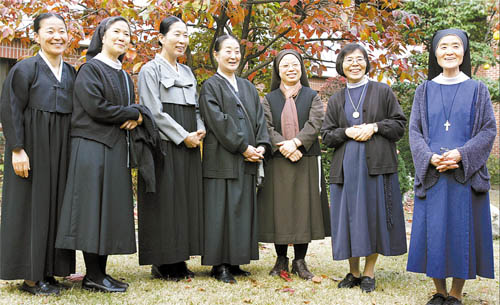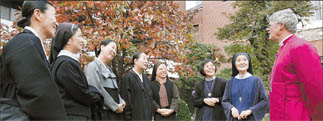‘Three smiles’ ― lessons in faith and true spiritual understanding

Members of Samsohoe at the Seoul Cathedral Anglican Church of Korea on Tuesday. From left to right: Reverend Choi Hyeong-il from Won Buddhism; Sister Beata Kwak, a Catholic nun; Reverend Jeong In-sin; Reverend Kim Ji-jeong; Lee Yang-ran, an Anglican nun; Noh Jong-suk, a Protestant monk and Sister Catalina Oh, an Anglican nun. By Kwon Tae-gyun
In the middle of the room she placed a potted plant, autumn leaves from a persimmon tree in the cathedral’s backyard, a cherub figurine and a traditional dol harubang, or “stone grandfather,” made of lava rock from Jeju Island.
Absent were crosses or other Christian iconography. This was a prayer meeting with a difference.
“The idea is to create an atmosphere for prayer,” Sister Catalina said Siste Catalina as the nuns broke into their opening hymn.
“Come, come the kingdom of peace. Let us be one.”
The group of nuns gathered at the church in central Seoul were not all Anglicans like Sister Catalina.
There were also Buddhist, Won Buddhist and Catholic nuns ― all of them members of Samsohoe, an inter-faith group.
So crosses, rosaries and amulets were kept stowed in pockets.
The plants and leaves around which the nuns sat had no religious significance to any of the religions represented at the meeting. Instead they represented a shared heritage and understanding that all the nuns gathered at the meeting could appreciate.
The term samsohoe means “a group of three smiles” in Korean. It derives from an old legend about a venerable Buddhist monk who never left his temple. He wanted only to meditate in the ascetic compound of his temple. But one day he ventured out to meet a couple of old pals: a Confucian poet and an expert on Taoism.
Just as the monk crossed a stream to reach his friends, a tiger roared from deep within the forest. The three wise men burst into laughter at the unexpected significance of the moment.
Ever since, samso has been used to describe friends with different religious backgrounds.
Samsohoe is the first association of its kind in Korea that consists of female spiritual leaders. The group started out in 1988 to raise awareness about the Special Olympics, which took place in the same year as the Seoul Olympics.
The nuns held a concert to raise funds for the event, singing different songs, from Buddhist chants to “Ave Maria.” Ever since, the nuns have met regularly to go hiking, hold retreats, send aid surviving “comfort women” and raise awareness about inter-faith dialogue.
Inter-faith problems have been noted in Korea due to the rising number of families of mixed-faith backgrounds.
Until last year, the sisters felt at ease with their common vision of “peace, love and forgiveness.” But in early 2006, the nuns decided to embark on a major journey that would test the limits of their tolerance and levels of acceptance. They set off on an 18-day pilgrimage to some of the world’s major religious sites.
“We prepared for this pilgrimage by meeting every month for five years,” says Reverend Kim Ji-jeong, one of Samsohoe’s founding members.
Their journey began in Younggwang County, South Jeolla, the origin of Won Buddhism ― an indigenous form of Korean Buddhism ― then proceeded to Varanasi in northern India, the most famous Hindu pilgrimage site, and then to England to visit a Quaker community.
After stopping to visit Canterbury Cathedral in Kent, they flew from the England to Jerusalem, where they visited a church where Jesus had supposedly wept, knowing the city would soon be destroyed.
From there, the nuns went to Assisi, Italy, the home of St. Francis, and ended their tour in the Vatican.
“At that time, we thought we were mature enough to solve spiritual conflict through our collective wisdom,” Kim continues.
“But after spending 18 days eating, sleeping and traveling together, and meeting spiritual leaders from other faiths, we realized the genuine need for respecting other people’s faith.”

An inter-faith gathering of nuns from religious groups in Korea discuss different ways to overcome spiritual differences during a meeting at the Anglican Church in Seoul. By Kwon Tae-gyun
There is a telling anecdote about the kind of problems that beset the nuns.
On their first night in India, a Buddhist nun asked her roommate, Sister Mary Kong, a Catholic nun from the Carmelite Missionaries, to stop killing mosquitoes.
Thereafter, Sister Mary had to endure mosquito bites whenever she shared rooms with her Buddhist sisters.
“It’s a whole different mindset,” says Sister Mary. “I still have an impulse to kill mosquitoes when I see them in my room, but now I try to chase them from my room instead. It’s my way of showing respect to my Buddhist friends.
“When I visit them in their temples, they wait until I finish my prayers before they eat their breakfast. It’s that kind of respect. We are living our own lives after all, but we support each other to live better lives.”
The Dalai Lama, the leader of Tibetan Buddhism, had a simpler way of encouraging inter-faith understanding during his private meeting with the Samsohoe in India.
He asked the nuns to practice “faith and respect” in their daily lives. His teaching left questions, though, which were too delicate to articulate.
There was a minor dispute in the Buddhist sanctuary of Varanasi. The Catholic nuns refused to bow during a ceremony in front of the site’s famous stone pagoda because the ritual was being videotaped. They were worried that the tape might cause some controversy if it was seen by other Catholics.
Later on, the Catholics nuns were upset when the Buddhist nuns chose to sit on a church pew instead of kneeling and praying near the altar at a church in Jerusalem.
On another occasion, a Buddhist nun was offended when Sister Catalina passed her a prayer note during an Anglican worship at Canterbury Cathedral.
“In a way, we were very naive before the pilgrimage,” says Sister Beata, a Catholic nun at the Benedictine Missionary for Sisters Daegu Priory.
“During the five years when we met and prayed, we didn’t tackle these practical issues at all. To be honest, we didn’t expect there would be such issues. We didn’t know that Buddhist nuns would have problems reading aloud a prayer that ends with the word “God” in every verse. They didn’t think seriously enough that Catholic nuns could get in trouble for bowing in front of a Buddha statue.”
On the night before the trip, the members sat down and for the first time talked openly about the practical handlings of worship.
Even so, there were tensions and regrets that grew into resentments during their pilgrimage.
The nuns were accompanied by journalists and a KBS TV crew. The subsequent documentary, “A Journey of Coexistance,” was well received when it was broadcast last year.
The title of the program reflects the spiritual experiences that the nuns underwent. They embraced differences while staying true to themselves.
In the program, Reverend Choi Hyeong-il, a Won Buddhist nun, used the metaphor of planting rice to explain the experience.

An inter-faith gathering of nuns from religious groups in Korea discuss different ways to overcome spiritual differences during a meeting at the Anglican Church in Seoul. By Kwon Tae-gyun
Back home, the nuns still meet regularly to chat and pray.
On Tuesday, the group had two special guests, a female monk from the Diakonia Sisterhood in Korea, an organization of Protestant female deacons, which is still not part of Samsohoe, and Frank Griswold, the presiding bishop of the Episcopal Church in the United States who is visiting Korea.
Griswold has participated in a number of inter-faith gatherings in the past, including his work with other denominations that oppose the war in Iraq.
During the Tuesday meeting, he shared one anecdote from the life of Thomas Merton, a Trappist monk who used what he had learned about Eastern religions to enrich his Christian beliefs.
“Merton came out of the dentist’s office in Louisville, Kentucky, one afternoon,” Griswold told the nuns.
“As he stood on the street corner, where I have also stood, he observed the men and women rushing by and saw them not simply as hurrying figures but, in their very ordinariness, transfigured and caught up in God’s glory. Merton had the ability to see the extraordinary in the midst of the ordinary,” Griswold said.
The story suggests that the formality of religion is less important than a person’s actual faith.
For Sister Mary, one of the biggest lessons of the pilgrimage was her realized immediacy of the need to construct greater inter-faith understanding.
“We tried to resolve misunderstandings as soon as possible,” she says, “even more trivial things, like who should take the left-over green tea from our trip. We settled matters straightaway.”
That sense of urgency was the inspiration for the title of a book about their pilgrimage: “Love Now, Forgive Now.”
By Park Soo-mee Staff Writer [myfeast@joongang.co.kr]










with the Korea JoongAng Daily
To write comments, please log in to one of the accounts.
Standards Board Policy (0/250자)